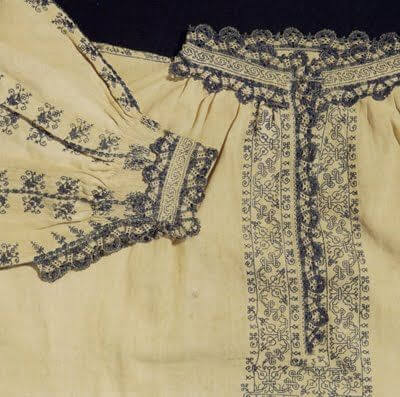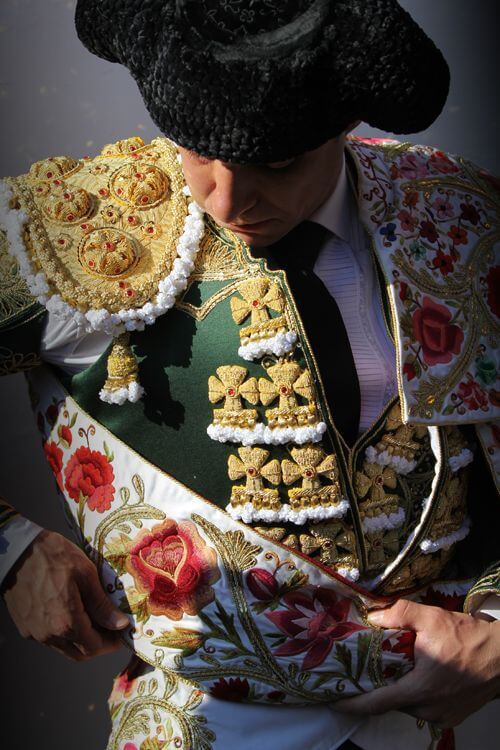The embroidered clothes of the southern part of Europe

The art of embroidery is multinational, but each country has its own unique colour that is transferred from generation to generation. Beautiful embroidered patterns travel not only within one country, but also cross borders, thus easily spreading around the world.
Traditional embroidered clothing of Italy
Italy does not stand aside from the artistry of embroidery and unique techniques used for the decoration of casual and festive clothes.
Imagine yourself being an ordinary Italian living in the Middle Ages and you will see that your house, clothes, even shoes are decorated with bright patterns, embroidered using a unique technique known as “bargello”.
This kind of embroidery can be identified by a distinctive pattern that resembles occasional flashes that’s why such a manner of embroidery is often called flare. The pattern fills the entire area of the fabric leaving no free space. The colours flow from one tone to another one, thus forming an overall picture. At the same time, the angles of separate segments can be both acute and smooth.
It is believed that the travelers and traders brought the first bargello embroidery to Italy from the East. However, this is still disputable, as there is no reliable information.

However, most Italian women prefer retelling a romantic love story of the Hungarian princess who married the heir to the family of Medici. Her dowry contained beautifully embroidered things that were adored by the women at the Royal Household. Since that time, the Italian craftswomen began embroidering things using straight stitches tightly connected with each other.
If an inquisitive tourist wants to know what one can embroider using bargello technique, Italians will smile and say that there are no limits:
- women’s blouses;
- skirts;
- men’s shirts;
- bags;
- pillows;
- towels;
- carpets;
- various elements of upholstered furniture;
- shoes etc.
Time passed and bargello embroidery got a new name – Florentine, because Florence is the place engaged in making such embroidered things.
There is one more unique technique specific to the Italian craftswomen known as the technique of trapunto, or multi-layer embroidery. Trapunto is literally translated from Italian as “embroidery”, while in translation from Latin it means “to run through with the needle”. The popularity of multi-layer embroidery dates back to the 17th century and it is still wide thanks to its unique beauty and elegance.
Using this technique, Italian craftswomen embroider extremely interesting and beautiful things. The volume is added in the process of embroidery, when a craftswoman puts additional strings under the pattern to have a desired effect.
Embroidery in Italy is an integral part of the country’s history and culture, as well as a look from the past into the present.
Embroidery in Portugal and Spain
The merchants engaged in trading spices and precious fabrics brought embroidery to Portugal, as well as to the whole Old World. Unlike other European countries, Portugal got used to embroidered things relatively recently – in the 18th century only. By entering an enchanting world of threads and needles, Portuguese women have adopted oriental patterns and adapted them to their cultural traditions, created a unique school of embroidery, and added some delicate elements.
The Portuguese appeared to be not only people of taste, but good entrepreneurs as well. From the middle of the 18th century, embroidery became a national product, and afterwards – the branch of light industry.
Only high quality fabrics are used in the Portuguese embroidery: linen, silk, organza, cotton. As a rule, the patterns are vegetable or geometric, embroidered in natural threads by hand or a specific embroidery machine.
Embroidered clothes worn only on holidays enjoy wide popularity in Portugal. In everyday life, the Portuguese prefer simple things, such as tablecloths or napkins with embroidered elements along the edges of the product.
Speaking about the tradition of embroidery in Spain, it is necessary to mention that the country stands aside from all the others. In everyday life, the Spaniards almost do not use embroidered things, except some individual cases.
The point is that bullfighting is more interesting for an average tourist, that’s why the Spaniards spare no gold and silver embroidery, quality velvet fabric. Moreover, the patterns impress by their refinement and richness. Only craftswomen with great experience can be engaged in making torero’s costume to prevent its spoiling, as it should play its role brilliantly.
Embroidery is also an essential element of the wedding outfit of a real Spanish woman. A Spanish wedding dress is traditionally black, adorned with fine patterns having symbolic meaning.
The art of embroidery is both ancient and modern, since it lives and develops according to its laws, makes people happy and provides unique moments and unforgettable impressions.

.jpg)

The art of embroidery is multinational, but each country has its own unique colour that is transferred from generation to generation. Beautiful embroidered patterns travel not only within one country, but also cross borders, thus easily spreading around the world.
Traditional embroidered clothing of Italy
Italy does not stand aside from the artistry of embroidery and unique techniques used for the decoration of casual and festive clothes.
Imagine yourself being an ordinary Italian living in the Middle Ages and you will see that your house, clothes, even shoes are decorated with bright patterns, embroidered using a unique technique known as “bargello”.
This kind of embroidery can be identified by a distinctive pattern that resembles occasional flashes that’s why such a manner of embroidery is often called flare. The pattern fills the entire area of the fabric leaving no free space. The colours flow from one tone to another one, thus forming an overall picture. At the same time, the angles of separate segments can be both acute and smooth.
It is believed that the travelers and traders brought the first bargello embroidery to Italy from the East. However, this is still disputable, as there is no reliable information.

However, most Italian women prefer retelling a romantic love story of the Hungarian princess who married the heir to the family of Medici. Her dowry contained beautifully embroidered things that were adored by the women at the Royal Household. Since that time, the Italian craftswomen began embroidering things using straight stitches tightly connected with each other.
If an inquisitive tourist wants to know what one can embroider using bargello technique, Italians will smile and say that there are no limits:
- women’s blouses;
- skirts;
- men’s shirts;
- bags;
- pillows;
- towels;
- carpets;
- various elements of upholstered furniture;
- shoes etc.
Time passed and bargello embroidery got a new name – Florentine, because Florence is the place engaged in making such embroidered things.
There is one more unique technique specific to the Italian craftswomen known as the technique of trapunto, or multi-layer embroidery. Trapunto is literally translated from Italian as “embroidery”, while in translation from Latin it means “to run through with the needle”. The popularity of multi-layer embroidery dates back to the 17th century and it is still wide thanks to its unique beauty and elegance.
Using this technique, Italian craftswomen embroider extremely interesting and beautiful things. The volume is added in the process of embroidery, when a craftswoman puts additional strings under the pattern to have a desired effect.
Embroidery in Italy is an integral part of the country’s history and culture, as well as a look from the past into the present.
Embroidery in Portugal and Spain
The merchants engaged in trading spices and precious fabrics brought embroidery to Portugal, as well as to the whole Old World. Unlike other European countries, Portugal got used to embroidered things relatively recently – in the 18th century only. By entering an enchanting world of threads and needles, Portuguese women have adopted oriental patterns and adapted them to their cultural traditions, created a unique school of embroidery, and added some delicate elements.
The Portuguese appeared to be not only people of taste, but good entrepreneurs as well. From the middle of the 18th century, embroidery became a national product, and afterwards – the branch of light industry.
Only high quality fabrics are used in the Portuguese embroidery: linen, silk, organza, cotton. As a rule, the patterns are vegetable or geometric, embroidered in natural threads by hand or a specific embroidery machine.
Embroidered clothes worn only on holidays enjoy wide popularity in Portugal. In everyday life, the Portuguese prefer simple things, such as tablecloths or napkins with embroidered elements along the edges of the product.
Speaking about the tradition of embroidery in Spain, it is necessary to mention that the country stands aside from all the others. In everyday life, the Spaniards almost do not use embroidered things, except some individual cases.
The point is that bullfighting is more interesting for an average tourist, that’s why the Spaniards spare no gold and silver embroidery, quality velvet fabric. Moreover, the patterns impress by their refinement and richness. Only craftswomen with great experience can be engaged in making torero’s costume to prevent its spoiling, as it should play its role brilliantly.
Embroidery is also an essential element of the wedding outfit of a real Spanish woman. A Spanish wedding dress is traditionally black, adorned with fine patterns having symbolic meaning.
The art of embroidery is both ancient and modern, since it lives and develops according to its laws, makes people happy and provides unique moments and unforgettable impressions.

.jpg)


Comments
No comment at this time!
Leave your comment